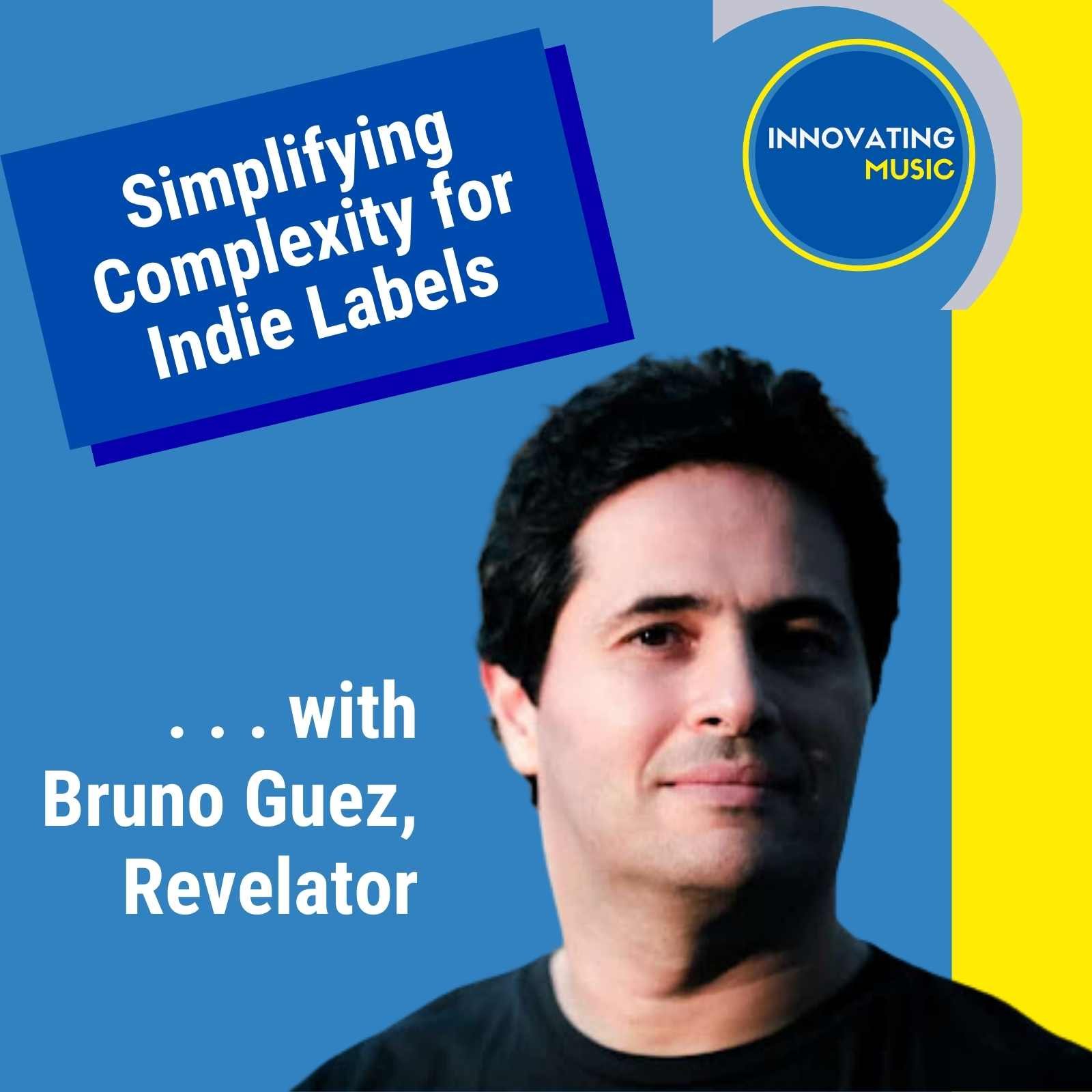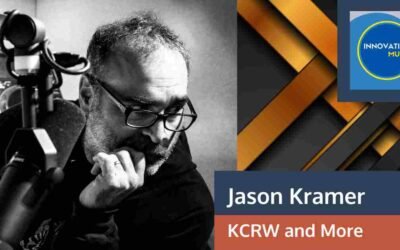Gigi Johnson: You presently run Revelator. Can you give us a 30-second, before we deep dive into your background, what in the world Revelator is?
Bruno Guez: Sounds good. Yes. I started the company close to about a decade ago coming from running a record label and understanding the shift and the digital transformation of the music business from a B2B perspective, from a label’s perspective.
Back then, 10 years ago, we didn’t have hardly any software or tools for running a label, managing digital IP, managing reporting and royalty obligations to rights holders. So I built the platform initially to help my business transform into a digital business and soon realized that there was everybody’s pain point and problem around data and royalties and payments and analytics and understanding more transparency around streaming data, those kind of things.
So Revelator became a B2B platform that serves distributors, record labels, publishers, artist management companies who serve artists, who serve rights owners.
Gigi Johnson: So if you’re an artist listening to this, you probably want to nudge your small label to say, are you using Revelator? But I want to get to the 10 years, but I’m going to drag you backwards in time because again, you’re a fabulous ethnomusicology person from UCLA, but you were born in France, right?
When you were a kid person, were you a musician? Were you an entrepreneur who was selling lemonade to your friends? So what were you doing when you were in high school? What was kind of the heartbeat of this that got started?
Bruno Guez: Even before high school, I grew up playing drums at the age of nine, listening to a lot of music from around the world. My parents are from Tunisia. I was born in France and we grew up in Los Angeles.
Listening to Brazilian music or reggae or Arabic music or soul was what we would normally listen to at home. It wasn’t very top 40 radio. It was Brazilian bossa nova and things like that.
Growing up, I was exposed to a lot of music from around the world. So I think culturally, I was already very much interested in discovering music from around the world, not just in my country.
That gave me already a perspective on life, a perspective on culture, a perspective on music because I was seeking interesting rhythms from African music and Cuban music and Latin music. I just loved flamenco music. I love culture and I love music. Ethnomusicology is exactly that. It’s the anthropology of music through culture in a way.
Gigi Johnson: And were your parents musicians? Because I must admit, my family, we had over-the-air radio and a few albums and definitely wouldn’t have had this exposure as a young person. Were your parents highly musical?
Bruno Guez: Not highly musical, but they loved music. Even listening to Bob Marley when you’re nine years old, that’s already great exposure.
But I think once I moved to LA with my parents, and initially we came for a summer vacation, and my mom just did not want to go back to Paris. After going to Yosemite and seeing Los Angeles — this is in the late 70s, so not a lot of traffic, a lot of great space — it was a fantastic life to live, the Sunshine State in many ways, compared to Paris where it’s cold and it’s gray and it’s not a great place to grow up in some ways as a young person.
The opportunity I saw, I started playing keyboards and synthesizers. I was into electronic music. This is the early 80s. So I was very much interested in the clash of culture and technology.
And when I turned 18, I kind of stopped being in bands and playing. I just didn’t know that I wanted to be a recording or performing artist. That was not my calling. But I knew that I loved music and I loved culture, and I had to figure out the path forward.
So I lived in Ohio for a while, and I came across an album by Ali Jihad Racy, who was a professor at the UCL’s Ethnomusicology program. And I said to myself, this is what I want to do. I want to listen to Ud. I want to listen to Arabic music. I want to play the Santor and learn about the Iranian, Persian classical music and things like that.
So I applied. I got in, and that was the beginning of my education in ethnomusicology. But it was so academic. And there was a disconnect for me between the world of academia and what was actually going on in world music in the 80s. So I wanted to be doing applied ethnomusicology.
So I started DJing, and I started bringing African music and Arabic music and dance music and French hip hop in the late 80s to clubs in LA. And I became a DJ. And from there, I became a radio host on KCRW. And I loved the whole 90s. There was a lot of great music coming from around the world, from the UK, from Germany, from Austria.
I was really good at spotting talent and developing an ear for music and saying, oh, these two tracks go really well together. Let me put it on my show. And I started discovering artists and broadcasting and promoting them.
And that kind of became the incubation of my record label in a way, because a lot of this music just did not have distribution in the early 90s. So I would call the artist and license the rights to use the music. And I learned about the music industry that way.
Because out of my passion for putting music together in compilations — today we call them playlists — but back then, we called them compilations of records. And we would put different songs on a CD, and that became a compilation.
So that’s how I got into the music industry.
Gigi Johnson: But you didn’t have a business background. So was this kind of a trial and error, learning how to manage a label? Or did you find people that were then some of that wisdom for you?
Bruno Guez: It was purely my passion to understand that I want to promote this music. So I had to learn how to license music and license the rights to music and do contracts.
Back in 1993, I had purchased a Mac computer with a stereo digital sound card. I taught myself digital audio editing and mastering, and I was making records.
After I released my first record, I had a chance meeting with a guy named Chris Blackwell, who’s the founder of Island Records, producer of Bob Marley, and many others for over 60 years. He came to my studio in Westwood and saw that I was a mad scientist. I basically had a record company in my living room — a computer in the middle of the room and records all over the floor. That was my passion: making records.
He said, “Let’s sign you as a label. You can probably make records a lot cheaper than I can. A U2 record costs a lot more than what you can do in your living room.” That was kind of the beginning of digital music in a way.
Gigi Johnson: So before that, were you making a full living doing this or was this part of a portfolio of things that put food on the table?
Bruno Guez: After university, I would DJ. I was earning $60 a night DJing for a whole night. By the end of my DJ career around 2000, I could make $5,000 a night. That was a big difference in a decade.
When you start, you don’t really think about the money. You’re not doing it for the money. But you could DJ three, four nights a week and make $1,000 a month doing that. That plus the record label was enough to live on.
When you’re in your early 20s, you don’t have a lot of needs the same way you do when you get older. It was a great time in my life. I really enjoyed traveling, going record shopping.
If you remember Rhino Records and Aaron’s Records, sometimes you’d go and find the one vinyl that was available in Los Angeles. I was one of the few DJs who had that record, and I’d play it on my radio show and at clubs.
There was a special relationship to music as culture, especially in physical format like vinyl. I miss that a lot today in digital music.
Gigi Johnson: Those listening to this on YouTube are going to see your face light up. But those listening in audio only are missing Bruno’s face totally light up when he’s talking about this time period. You have this joy on your face talking about this.
So then you went and were part of someone else’s label, but with your own sub-label brand continuing, correct?
Bruno Guez: Island Records was our distributor, but it was our label distributed by Island Records. Then Universal purchased Polygram. I continued my work with Chris Blackwell directly through his new label called Palm Pictures. Then I started becoming an independent label in the early 2000s.
I’ve been independent ever since. I don’t release as much music today as I did last decade. Ultimately my interests started shifting to figuring out how to use technology to streamline the complexities of running a record label.
In 2003, I already had a deal with Apple. I was selling on iTunes, dealing with digital, and learning about the complexities and challenges of digital around metadata, reporting, and data processing.
The challenge I saw was when Spotify came out in 2007–2008. Until then, downloads were a great business. We were able to have eight people in the company. For a small label, that’s meaningful — you can release, promote, and market music. We were doing a lot of sync licensing for film, TV, and advertising. We had found a market for this lifestyle niche boutique label.
But when I saw the rise of streaming, I said to myself, “We’re going to be in trouble.” It was going to cannibalize downloads, and the unit economics on streaming are just not the same.
Gigi Johnson: That’s a polite way to put it.
For those who this may not be your jam — the revenue per unit was low. And the detail and hassle per unit didn’t necessarily change. You had data coming in for penny fractions instead of larger units, still with the same per-item data processing.
Bruno Guez: Yeah, you go from getting 70 cents per download or $7 per album download to getting $0.0035 per stream — and your file now has a million lines in a CSV.
Gigi Johnson: We’ll swing back to the current work you’re doing, but let me take you in a different direction. You also became more of a lifestyle curator, right? Whether working with Cirque du Soleil or a hotel chain, you were bringing music to place.
I’ll call it a left turn, but to me it aligns wonderfully with your label. How did you get into place-based music? And why are you not still in place-based music?
Bruno Guez: When I was running the label — let’s say 2004, or even before — in the mid-90s, I started creating compilation records. Those records had a lot of great world music.
Chris Blackwell had a chain of hotels in Miami, the Bahamas, and Jamaica called Island Outpost. He asked me, “Can you create the soundtrack of the hotel experience with your records?”
I’d travel to these locations, learn the vibe and feel of those places, and put together soundtracks and playlists that captured the space. It was an amazing time because I got to travel a lot and create a kind of sonic architecture for the brand.
What does GoldenEye in Jamaica sound like? What does Eleuthera in the Bahamas — a place called Pink Sands — sound like? Each property had its own vibe.
I curated music for these properties, made records as part of that, and even sold records in the minibars. This was 20–30 years ago, when people discovered music during their holiday, and it became the soundtrack to their vacation.
I loved connecting lifestyle experiences around music and helping people explore and discover new music through that distribution — what I call lifestyle distribution.
When I got to LA, places like Oliver Peoples, a high-end eyewear company, were the first to sell our records in their shops. This was 1995. Then we did compilation records for American Rag on La Brea, Yobe Studios, and others.
We were always looking for new ways to distribute music that would never make it onto commercial radio. Lifestyle distribution was really interesting.
Gigi Johnson: And I think for a lot of people, I wanted to make sure that you talked about that, because a lot of people don’t realize that entire space exists. I keep running into people who currently do this, and I’m always fabulously baffled that this is an area of expertise. But it’s a unique branded element — the sonic architecture of a place — which I find a really interesting business model that can be much more lucrative at times than some of these other things we’re currently dealing with.
Let me bring you back to both what you’re doing now and how in the world… You traveled a lot, and then you decided to move your family to Israel. You’re now running this business you’ve been incubating for 10 years from Israel, which is why we’re talking in the evening your time.
How is it to be running and growing this? And how do you deal with it as an international company?
Bruno Guez: Initially, in the early days — up until about 2015 — it was really me building the core software infrastructure layer and application layer so I could run my business, start distributing for other people, and bring more efficiency to the business of music.
When we went to market in 2015, we found interest and demand for our products, specifically around analytics, because people didn’t have good visibility into streaming data. While analytics are important, the most interesting part for me was following the money: how do we do royalty payments, get people paid faster, accelerate payments for rights owners?
That’s been my thesis for the last five, six, seven years — to accelerate the flow of funds to all the rights owners involved in a song, recording, or composition.
Gigi Johnson: You’ve already talked about starting as a drummer and loving music, but not being the tech guy. You taught yourself how to use the early Apple computer. Are you now the tech guy? How did you become the tech guy? Do you have a battalion of tech people that make you the tech guy?
Bruno Guez: Back in the mid-90s, there were no databases for us to easily manage metadata. I had to keep track of credits on all the records I was licensing and producing using FileMaker Pro. I built FileMaker Pro databases to track credits and who we needed to pay.
Fast forward to 2003–2004, the beginning of the cloud — I started looking at using Salesforce as a CRM for managing all my label’s metadata. I learned how to use cloud-based software for creating relational databases: tracks, releases, artists, and mapping all that information to keep track of what a label needs.
By 2004, we were already doing SEO optimization for landing pages so if someone Googled “Why was that song in Grey’s Anatomy?” we’d be one of the top results. We created landing pages for every license in film or TV, with relevant keywords, to capture emails, grow artists’ audiences, and automate discovery and purchase links.
When I got to Israel, I wasn’t going to sell a product based on Salesforce, but I had built the prototype a decade earlier to manage a record label’s metadata, data structure, and schema. That became the foundation for building better tooling and software so I could run my label without hiring 10 more people.
I didn’t believe streaming subscribers would grow fast enough to offset the loss from downloads, so from 2009 to about 2014, I didn’t see a big business in running a label. The risk was still too high. Streaming was exciting but not yet big enough.
When I started developing the tooling, I already understood metadata structure, rights info, contracts, and data models. It came naturally. I hired a development team, told them, “This is the data model for a track, a release, an artist, a DSP report,” and so on.
I became more of a product guy than a tech guy, but I understood enough tech to make the product user-friendly. I cared a lot about user experience and was frustrated by products that weren’t intuitive. I put a lot of effort into making complex music data manageable.
We redesigned our product three times before releasing it in 2014–2015. That version lasted seven years. Now we’ve rebuilt the front-end app so it’s responsive, works down to mobile, and localizes into 25 languages, including right-to-left like Arabic and Hebrew.
Gigi Johnson: These are not easy things to do.
Bruno Guez: No — but once you’ve done it and learned what you should have done differently, you want to do it correctly next time. We’ve done a really good job now.
Gigi Johnson: Let me point to current and forward. Looking at your website, I noticed you have a category for Web2 products, which implies there are Web3 products in the pipeline, and that you’re offering business intelligence tools. Can you talk a little bit about the forward direction, where you’re inspired to take your B2B clients and toolsets worldwide?
Bruno Guez: Streaming business models provide two data sets: financial data, which comes monthly, and consumption data, which comes daily. For most artists, labels, and distributors, it’s important to understand daily consumption — where your songs are streaming, in which markets and platforms — to inform marketing decisions.
It becomes a data infrastructure problem because of the volume. Processing billions of streams a month from many different platforms is unmanageable for most companies. So we automate the process: collecting, aggregating, normalizing, ingesting, deduplicating, matching — so you can just look at a dashboard and understand what’s going on, and your artists can see where they’re performing.
If you can accelerate the pace at which people get information about their assets, it’s useful for marketing, financial management, investment decisions, and providing advances to artists. I’m now excited about automating catalog valuation so any customer can understand their work’s value in real time.
It’s hard to gather all the data and share it with potential buyers or lenders. My focus is: can I accelerate payments, and can I automate understanding of value — even if you own 33% of a song — and open up fractional ownership markets or royalty stream sales?
Gigi Johnson: Or subdivide your portfolio so buyers can see a representation of the financials and transfer a sub-database to a new owner or investor.
Bruno Guez: Absolutely. The idea of creating baskets of songs with their cash flows and valuation metrics, making it seamless so you can accelerate underwriting and share with interested parties — that allows independents to more easily sell or fractionalize their catalog, get financed, or access working capital.
Majors have teams analyzing catalog purchases of Neil Young, Bob Dylan, Bruce Springsteen for hundreds of millions. Independents don’t have those tools or opportunities. But over the next five years, I believe the growth of independents will continue, and with it the growth of financial services funding them. Better tools mean more opportunity for liquidity and exits.
Gigi Johnson: My last question is then a future direction, which is the Web3 side of the house — rethinking the connective tissue. I’m assuming that’s part of your heartbeat going forward. How are you looking at Web3 opportunities, and is there anything you can share that you’re tinkering with?
Bruno Guez: We’ve been developing Web3 infrastructure for four years, initially around a digital wallet for creators to manage their rights, royalty flows, and payments. We connected streaming royalty data from the Revelator platform to those wallets so any rights holder could receive their share of the money flow and request advances against future cash flows based on consumption data.
The music industry is interested in NFTs and digital collectibles. I see three marketplace opportunities in Web3: digital collectibles, licensing into Web3/Metaverse/gaming applications, and securitization — selling IP or fractional IP to compliant, regulated marketplaces offering tokenized securities for music IP.
Over the next five years, the streaming landscape will change. New marketplaces will open up — more direct-to-fan, tokenized economies, fan-powered communities. Streaming income will become just one input into the value of IP that can be monetized as a digital asset across marketplaces, whether as a collectible or licensed into platforms like Decentraland or The Sandbox.
Gigi Johnson: There may be places where people are actually going — but that’s a whole other discussion. We’re recording this in October 2022, when people are asking how many are actually showing up in these spaces. You could have a music data side that validates that.
Bruno Guez: Completely. I love Web3 infrastructure. We’re moving from a Web2 internet based around information flow to a value-based internet where value gets exchanged between parties. That will create more opportunities for engagement, direct-to-fan, direct-to-collector, and community building. I think that’s really exciting.
Gigi Johnson: Well, Bruno, we’ve been talking for a while. It’s been great talking. Is there anything we haven’t talked about that you’d like to cover before we wrap up?
Bruno Guez: The only thing I’d add is — I’ve never been more excited about the music industry. I’ve experienced different phases: the analog world of the ’80s and ’90s, the digital 2000s and 2010s, and now this third shift in business models and distribution channels.
It’s the most exciting time in my career. While it may seem cryptic and complex, and people often associate blockchain with cryptocurrencies, blockchain is just the underlying technology — and it’s so much more than that. I’m really looking forward to seeing how this next era unfolds.
Gigi Johnson: Bruno, thank you so much for joining us.
Bruno Guez: Thank you, Gigi. It’s been a pleasure.









